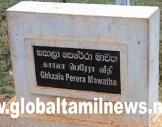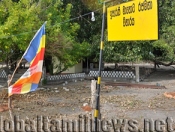In the guise of solving the problems of the Tamil people, Rajapakse government is engaged in Sinhalizing the traditional Tamil villages in the North and East.
165 Sinhalese families settled in Kokadivankulam in Themmamadu in the Vanni area and the name of the village has been changed to Kalabowawela. This is the latest example of this act, Member of Parliament Sumandhiram points out.
The renovation work of the tank in Kokaadivankulam was given to the Vavuniya G.A and the Vavuniya South Sinhala Divisional Secretary on the orders of the Minister of Economic Development. After the completion of the above work the Department of Agrarian Development cleaned up the 200 acre paddy field around the tank for cultivation and settled 165 Sinhala families in the area while chasing out Tamil families who lived there.
Vavuniya Sinhala Pradeshiya Sabha handed over the deeds for these lands which had been forcibly acquired.
Meanwhile TNA parliamentarian M.A. Sumandhiran has disclosed that 20 million rupees has been allocated to renovate the road form the town of Maakachikody to Kokkadivankulam and 1500 acres has been reserved for the expansion of the Cheddukulam army camp and lands in the Kanakarayankulam area are being forcibly acquired, Sumandhiran adds.
Meanwhile lands of the Tamil people are forcibly acquired at will and army camps and barracks come up in these places. Traditional areas where Tamils fished, cultivated have now become places for fishing, cultivating and working places of the Sinhalese.
Buddhist statues and symbols are erected at will in areas where Hindus and Christians live. By doing so the lands of the Tamil people are not only captured but Sinhalized, and the language, along with the religious and the cultural aspects of the Tamils are destroyed as well.
Continuous land area where the Tamils traditionally lived has now been separated by the above reasons. Tamils become minorities in their own lands where they lived as a majority group some time ago, alleges TNA parliamentarian Mavai Senathirajah.
Many such activities proving these allegations are continuing.
Three roads close to the A9 highway in Kanakarayankulam are given Sinhala names. The people of the Kanakarayankulam area are very saddened by this, while the cemetery of the area has now become a big army camp.
The military has built small houses for the people who had lost their houses during the war and instead has given Sinhala names for the streets in the area, but the earlier names given to the streets according to the Tamil culture and language are still in use.
Kosala Perera road, Anura Perera road, Rev Yatiravana Vimala Thero Street are the three names given to the roads. The first two names are from the soldiers who took part in the war against the Tamils and the last one is a name of a Buddhist monk.
The people say that changing the Tamil names of the streets which have been used for ages in the areas where the Tamil people live, to the Sinhala names is an act that cannot be accepted and urge that the names that have been used all along be inserted once again.
A Buddhist Vihara named Mahatota Raja maha vihara has come up within 50 meter distance of famed Thirukethiswaram temple in the Mannar district. The ancient traditional name for Thirukethiswaram area was Mahathottam. This was anciently a port area and is called Mahathottam or Manthai Rajamaha Vihara.
Mahatota Rajamaha Vihara is built under an old bo tree on the way to Thirukethiswaram along the A 32 highway. The vihara has been completed and opened up recently and decorated with bright lights. The name board of the vihara is not in Tamil or English but only in Sinhala.
Local tourists going from the South especially the families and relatives of the soldiers take shelter under the trees, have their meals, dance and enjoy a bath in the Palavi theertham (holy bathing place) as well.
The holy place of Palavi which has been blessed with Hindu religions hymns where Lord Kethiswaranathan and Goddes Ambal take the holy traditional bath has now become a place of leisure.
The buildings, the shore of the river are modernized and the holy Thirukethiswaram are has now become a part of the Mahatota Rajamaha Vihara and has lost its purity and is now a garden of pleasure for the Sinhala pilgrims.
In time to come emperor of archelogy Ellawela Medhananda thero will come up with a story that Thirukethiswaram area is a traditionally Buddhist area. The modern Dutugumunu Mahinda Rajapakse will then get ready to write what this emperor of history is saying in the rewritten Mahawamsa.
With the story of Thirukethiswaram being such, a Sinhala settlement has suddenly come up close to the Murunkan agricultural farm at the Murunkan area along the Mannar Madawachi highway.
This area from where clay sand was gathered belongs to the now defunct KKS cement corporation, and is opposite the junction leading to the Murunkan agricultural farm along the street going towards the Katkinda tank in the Mannar Madawachi road.
Sand clay is not dug up anymore from this place as KKS cement factory does not function and because of the war. It is at this place the particular group of more than 25 families has put up huts with cadjan and preparing the environment for their permanent stay. But the people of the area say the Sinhalese did not have even a single house in this area before the war.
Buddhsit flags in Blue, yellow, red and white fly over these newly created cadjan huts confirm the Sinhala chauvinism. The Madhu junction on Mannar Madawachi road is about 10 to 15 kilometers from here. This is commonly known as Madhu Junction or Madhu road. There were 10 to 15 families in this Madhu junction before the war, but now there are more than 100 families living here, having put up huts and boutiques. Efforts are being made to appoint a separate Sinhala grama sevaka to this area where the Sinhala families live.
A small shed with a Buddha statue which stood under a tree has now become a large vihara. A dialog telecom tower has now come up inside this vihara.
Sri Lanka navy built a school for the families who had settled here. Meanwhile it has now become known that more than hundred permanent cement houses are hurriedly built in the area north to this street and beyond the railway road. No name has still been given to this settlement, butitwill called a village or scheme with a name in front sooner or later. Earlier this area was a thick jungle and this jungle has been cleared and the housing scheme is coming up in a hurry.
Meanwhile at 12 kilometers from the Madhu junction and on the right side of the road there was a Tamil village called Poomanaththan. More than 50 families lived there before the war. With the beginning of the war most of the families went to India and the village became derelict. Here too houses for Sinhala families are built and settled there, but not even one Tamil family is seen there now.
Beyond this on the Madhu road between the 2nd and 5th Kilometer on the right side there were many grape farms earlier. Now this area has been abandoned. It is told that Bastiam Pillai was killed in this Vineyard, This farm was in the control of the liberation tigers before the war but now the military has taken charge of the farm.
Before 1985 there was an attempt to settle Sinhalese in this area but the Sinhalese who were taken there were unable to live there and went back. Efforts are now made to bring electricity to the area form Vavuniya through Sinna Pandivirichchan and Periya Pandivirichchan. Electrical posts have been erected and wires have been connected. Every effort to turn this into a big Sinhala settlement is taking place.
A 32 highway from Mannar goes through Mulangavil, Poonakari and is known as Sangupitti, Kaaraithivu road and joins the A9 highway at Navatkuli. Mahinda Rajapakse recently opened the Sangupitti Karaithivu Bridge which was built with the help of the British. This road is not well renovated except for the bridge. The road is still not perfect for transport.
The first village in this road is known as Valikamam. There was a big farm where this road meets the main road which goes to Mallavi, Thunukkai and Kalvilan. There were 2500 goats and other farm animals and long term plants such as mango and jak and short term crops such as grapes and vegetables. Liberation tiger’s treasurer Thamilendhi was in charge of this farm. Roads had been constructed there for inspecting the farm and for which a special tractor had been assembled. This was an important farm for the tigers and was yielding good income. The prisoners of the tigers worked there. Now this farm has been acquired by the army.
Like wise Mutkomban was a place in Poonakari A.G.A division. Vellankukam belonged to Mannar district. This incidentally was the last village of Mannar. Mulanggavil which is close to Valikamam in the A 32 highway belongs to the Kilinochchi district.
There was a farm in Mutkomban as well, and that belonged to the tigers. There were 3 grape farms on the same main road. These farms were between Mulangavil and Poonakari and on the left side of the road that is on the short side and in the deep jungle. In one of these farms a board named Nachchikuda police station is seen hanging, but this farm is at a very long distance from Nachchikuda.
The grapes farms are now expanded, through planned and continuous acquisition of these farms.
By doing so the Sinhala chauvinist government of Mahinda Rajapakse and his security forces are trying to make the Vanni mainland a Sinhalized area where the Tamils who live there have now become a minority.
GTN

